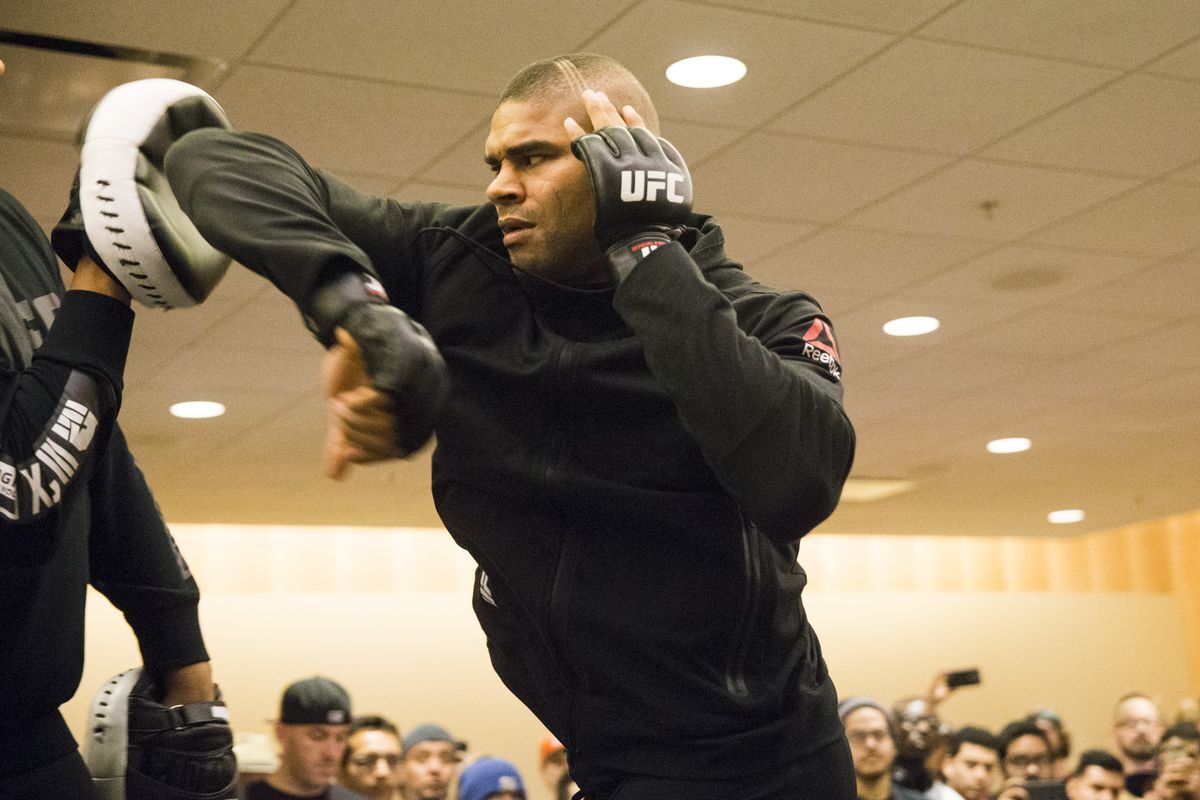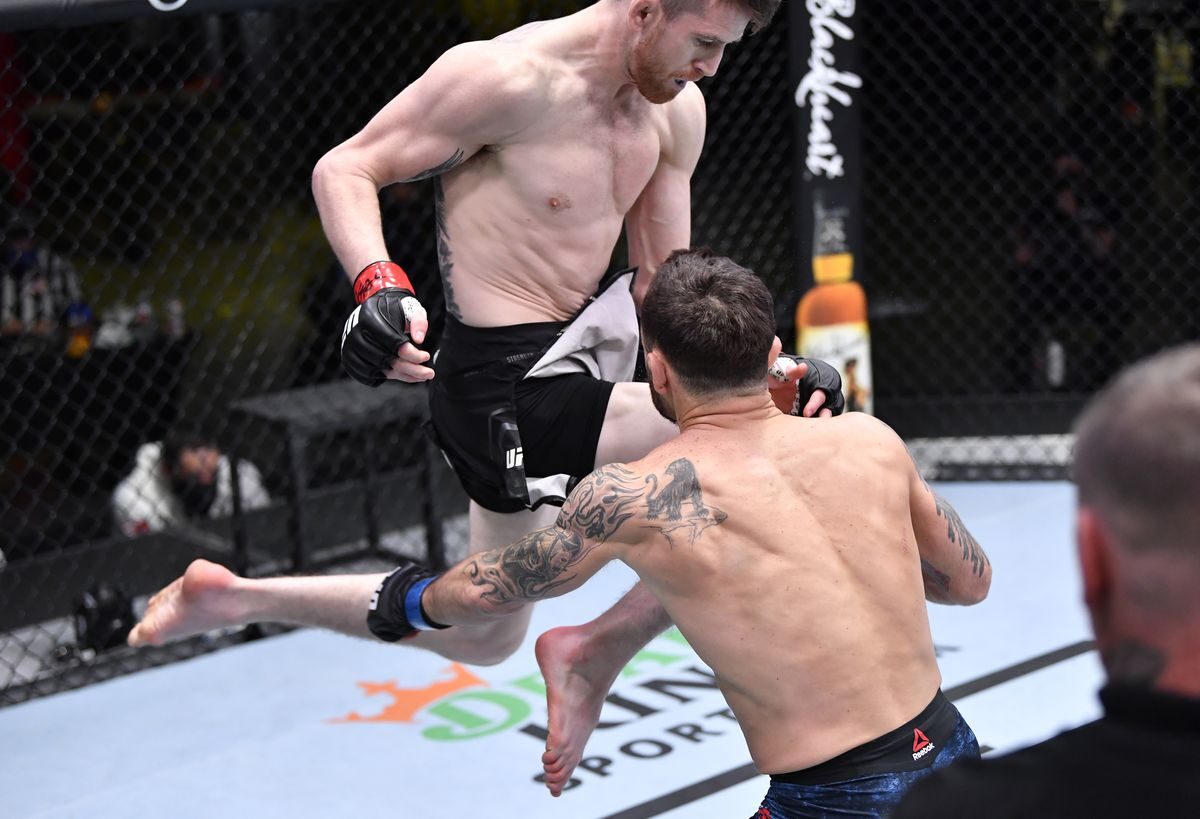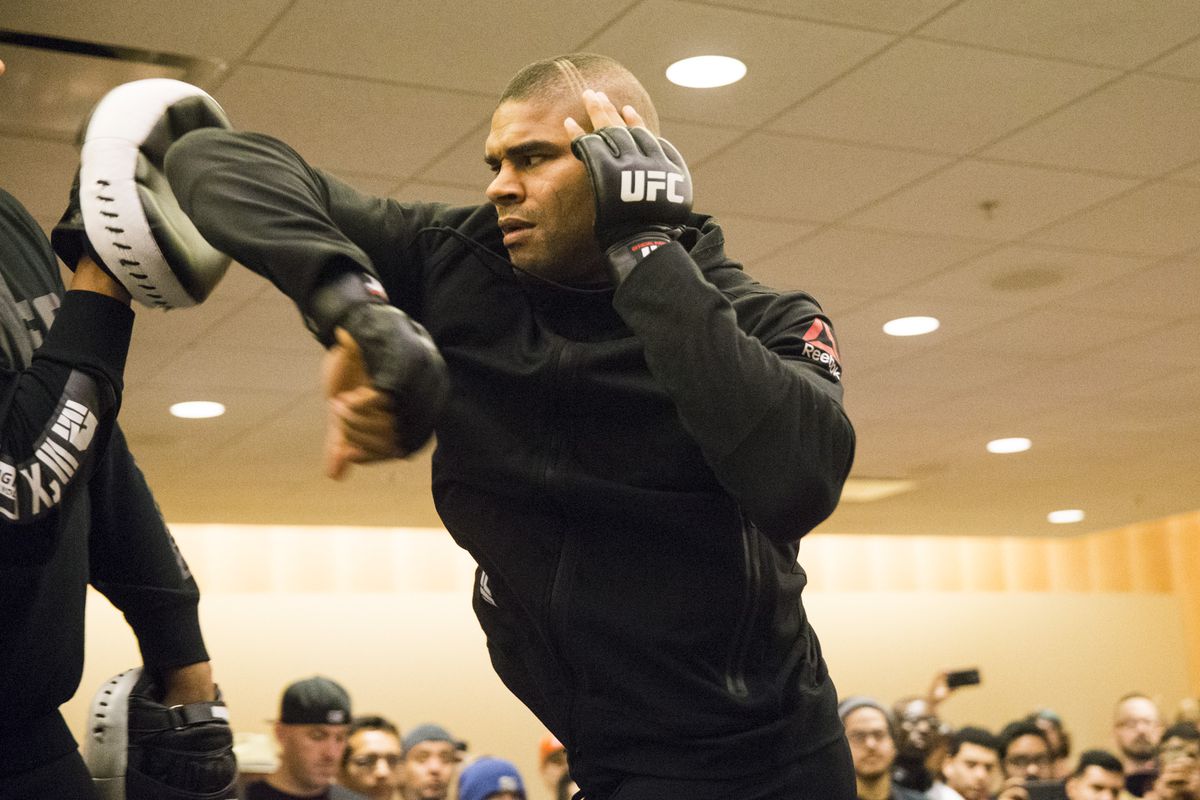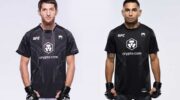Listen closely, and the sound tells the tale. It’s thunderous.
Thwap. Thwap-boom!
A swirling melody with low and high notes as well as backbeats, off-rhythms, and other rhythms. It explodes through the air like an orchestral cannon.
Thwap. Thwap-boom! Thwap, boom-BOOM!
Francis Ngannou pauses to reset, letting the tremors from his right hand settle. Watch any pad session between the UFC heavyweight champion and coach Eric Nicksick, and the soundtrack the two produce is the most jarring part. The harmonies of 100 miniature car crashes colliding with effortless precision. It’s enough to make your palms sweaty.
In the summer of 2020, nine months before Ngannou dusted Stipe Miocic to seize the crown as the most dangerous unarmed combatant alive, Nicksick gave the world a taste of his average Mondays when he posted a point-of-view clip of the soon-to-be-king charging at him lobbing haymakers from every angle. “I hope you get hazard pay,” joked one fan on Instagram. Normal people merely stared dumbfounded in awe. The life of Xtreme Couture’s head man is not something for the weak of heart, even on a regular afternoon.
Like most coaches in MMA, Nicksick juggles many hats. But the role he first assumed during his early days in the gym is one he still wears with pride: That of a padman.
It’s not exactly glamorous work, sacrificing one’s body day after day at the altar of the world’s deadliest athletes. Nicksick is a seasoned professional with many stories to tell after more than ten years of service.
Oh, does he have stories.
“Francis has hit me through my pad,” Nicksick says with a laugh. He’ll grab my cross, and his hand or my hand will strike me in my mouth. Or crack my face until I feel rocked.
“Then Francis on the ground-and-pound, he’ll throw elbows and your head is still on the ground, you have nowhere to go. My head is literally ricocheting off the canvas.”
Nicksick isn’t alone. Ask any pad-holder worth their salt, and they’ll have something for you.
“The biggest injury I had was getting off rhythm with Alistair Overeem — and I took a left knee to my sternum,” says coach Brandon Gibson of Jackson Wink fame. “While I lay on my stomach, staring up at the lights in the gym, I worried that I had torn my aorta.
“Like, ‘Oh f***, am I bleeding out in my chest right now? !’ But no, I wasn’t.”
On the totem pole of MMA celebrity, pad-holders reside in an awkward place. They are not well-known to the masses, but their talent and sacrifice make it possible for us to see the amazing displays every weekend.
In many ways, it’s a thankless gig.
The layman critiquing from the sidelines may not understand the differences between the sights at a UFC open workout and the 9-to-5ers blasting mitts in a local boxercise class, but for the ones taking the beatings, the challenges involved with being an MMA pad-holder make it one of the most volatile — and demanding — roles in all of professional sports.
“I’m almost 50,” chuckles Fight Ready padman Eddie Cha. “Internally, I’m like 66.”

Esther Lin, MMA Fighting
So why do it? What is the role of padwork in MMA, how has the trade evolved since the era of clueless barroom toughs, and what distinguishes the best in the game?
MMA Fighting spoke to several of the most decorated mitt workers in the sport and the answers were as varied as the disciplines that make MMA what it is today.
Because here’s the thing: The pads? They can be anything and everything all at once.
“There’s so many methodologies of pad-holding,” says striking coach Sean Madden. “Like, you could use pad-holding for conditioning. You could use pad-holding for timing. Pad-holding could be used to build combinations in fights, or for timing.
“I would be actually interested to hear from other coaches on the percentage of what is the distribution for each athlete of their pad work. How much of it is conditioning? How much of it is tactical? How much of it is reactive? Because you can use pad-holding for a lot of different things, and I think that’s something people don’t always understand or appreciate.”
It’s an art that’s become particularly tricky over MMA’s past three decades. It’s not hard to see. Boxing may be regarded as the sweet science, but its pad-holders are mainly concerned with variations on a theme — two hands, two weapons, how can we make the best use of both? MMA, by comparison, exists in a wholly separate universe, one with infinite answers to every question. Kick or punch? Shoulder or knee? Is it better to use a level-change or combine the two after feinting? The work must reflect that, says Nicksick, “or it’s like ordering two meals at separate restaurants, and it just doesn’t go together.”
“So for example, I remember holding pads for Colby Covington, and it was like we fought,” he says. “My pad session was like we just fought for 25 minutes straight. Throw overhands and throw our body series. We will set up the level change for our overhand or step-in. And we flowed really, really well the first three or four times that we hit pads together, but it was like a f***ing MMA session.”
That type of reactive work is common among top MMA pad-holders, a delicate balance where both individuals walk a tightrope in a free-form flow, their only guidance being their instincts and their eyes. The No. 1 trait required of an MMA pad-holder was nearly unanimous for every coach who spoke for this story: Adaptability.
Without it, a mitt worker can become a danger to both themselves and their fighter.
“I think of it like a baseball catcher. Like, they have to be so dialed-in and so focused to catch the slight variations in each pitch, and that’s how I feel with each combination,” says Gibson. If I am out of rhythm, or if my tempo is off, that can impact the entire combination. And I’m at greatest risk. I’ll catch a shin to the head if my high-kick Thai pad placement isn’t in the right spot, or I’ll eat a knee to the face if I’m not properly braced enough in a Thai clinch to catch a knee to the body or an elbow.
“There’s a really cool picture I put up on my Instagram a few months ago, and you see Jon [Jones] throwing an elbow — and it must be like two millimeters from my nose. And to me, when I talk about the range and the speed and the trust that we have, good pad-holding should be as close to the target as possible, so it’s applicable when the fight comes.”
The philosophies vary from one mitt worker to the next, but they all lead toward the same conclusion. If you think of striking as music, each fighter carries their own unique rhythm, and that rhythm changes by the day. You’ll often see artists, who have a canvas. I think martial artists are the same way, and the floor is our canvas, right?” says Cha.
“Every time we move and get through a sequence, it’s a different kind of a pattern. It’s an art. And if you have padwork — like good, real clean stuff, guys we’ve been hitting with — it almost sounds like beat. Bap! Bup-bap! Bap-bap-bap! Bup-bap-bap! It’s a clean beat when you’re feeling that chemistry.” Those beats can be endlessly varied, from the rollicking double bass of a 115-pound strawweight to the plodding trap beats of a 250-pound heavyweight, it’s all on the pad-holder to read the tempo of the room.
Take Gibson, for example.
He has two main students he works with these days. The first is Jones, the former UFC champion whose extraordinary physical gifts have now ballooned into a hulking heavyweight frame. “With his 84. 5-inch reach, my range perception is very different, right? Gibson says Jon’s power is quite different. We have so many rounds together that there is an extremely high degree of trust. So Jon will throw, for example, an incredibly hard spinning back kick, and he knows I will be in position to catch it. And it’s one of those things that, if he was maybe two inches off either way, it could be very damaging to me — kicking me in the neck, or on the chin, or on the nose, or in the groin.
“But the trust is there, and he knows where I will be.”
Gibson’s other main disciple, however, could not be more different: Aaron Pico, the featherweight dynamo whose dazzling speed unleashes mitt sessions at a Tommy gun pace. Gibson states that a Jon Jones spinning back kick was the most difficult strike I’ve caught. Gibson adds, “But a Jon Jones spinning forward kick is overall one of my hardest strikes I’ve ever caught” Aaron’s work is primarily in his striking, which he uses to locate his wrestle takedown entries. He said it in his last fight, I’m just as much of a wrestling coach in my padwork as I am a striking coach.”
Nicksick can relate.
In an average day at Xtreme Couture, he can land on the receiving end of blows from a grenade launcher like Ngannou to a piston-puncher like Cody Garbrandt to a tweener like Brad Tavares, each presenting varying skill sets and body types. “When I hold pads for Cody Garbrandt, you’re talking speed at a 10,” Nicksick says. Sometimes, I feel Cody needs to slow down to allow me to get the pads in order to catch up. Then like today, Maki [Pitolo], he’s fighting a southpaw, so I had him actually throwing the inside leg kick with no pad on. He was literally kicking me in the leg. It’s not like I am checking it. I’m just f***ing enjoying the kick. And then you hold for Francis and a lot of that is like: Just don’t get killed. You hope to God he doesn’t miss.”
But they do miss. Inevitably, they all miss.
It’s funny. The only coach who spoke for this story who offered a dissenting initial response when asked for the No. 1 trait needed by a world-class MMA pad-holder was Joe Lopez, the longtime trainer and padman for UFC featherweight champion Alexander Volkanovski.
His answer was much, much simpler.
“Good elbows,” he laughed.
He’s only joking, of course, but not really. Lopez is 59 years old and decades deep into the game. He lost count ages ago in regards to the number of times he’s been sent to the rehab room by one of his students. “You just need that one wrong punch, where you mistime it or they hit the top of the pad and you’re not ready for it,” he says. “It’s more so with the hooks than anything, if they hook wrong and you sort of kimura yourself. It can take a while for the wound to heal once it has happened.
“Everyone’s relying on you and you’ve just got to tape them up every day and just grin and bear it. Take a few anti-inflammatories and just push through.”
Therein lies the rub for pad-holders: There truly is no offseason. Between fight camps, fighters have the opportunity to rest and heal. The coach is not allowed the same privilege — the pressure of pushing through to the benefit of athletes’ performance can become overwhelming. “You talk about holding pads over an eight-week camp, it can get to be a lot on the body,” says Madden. Madden says, “As soon we complete a camp together, we move on to the next guy or we are in the middle already of another camp for the other guy.”
“Pad-holding is year-round. I would say I’ve accumulated way more mileage holding pads the last six, seven years than I did fighting, and I think that says a lot.”
It’s a stark and unavoidable reality. Nicksick claims that his shoulders look a bit messed up. Cha claims he suffers from bursitis at both his elbows, to the point that he cannot brush his teeth or wash himself. Madden says he has all of the same shoulder and elbow fun, along with a few ribs that have “come out” from wayward shots mid-session. As a special treat, his hands have also naturally begun to curve inwards, as if he’s holding some sort of nightmarish perpetual focus mitt. Madden laughs, “My body just takes the form of a padman,” Madden says. “It reflects my work. And in other ways, in 20 years, I know I’m going to be f***ed from it. But it’s the life that we chose.
“I talk to Trevor [Wittman] about it all the time. Imagine holding for someone like [Justin] Gaethje on a regular basis, and Kamaru [Usman] now who’s learning how to f***ing hit hard. His body is trashed, too.”
The entire endeavor can turn into a twisted game of oneupmanship. Gibson’s pad-holding mentor, Mike Winkeljohn, even donated an eye to the trade when his right eyeball was sliced in half by the toenail of a longtime kickboxing student during a pad session in 2009. He’s since compared the aftermath of the scene to the shriveling of a grape. The only fighters who can hold their own when they are at their most intense will be the strongest mitt workers.
“There are definitely times where you catch [a strike] where you’re like, ‘F***, that was crazy!’” Gibson admits with a laugh. “Right?”
“‘S***, that almost got me! Smarten up, Gibson. F***ing pay attention.'”
It happens to everyone. Gibson was once flushed head-first by Carlos Condit during a UFC Open Workout. Lopez, likewise, has eaten plenty of body shots from his perpetual troll Volkanovski. “I’ve got to make sure that my guts are tense the whole time,” Lopez laughs. “If I relax for a minute, mate, I know I’m going to cop one.” Nicksick has own serial offenders, particularly UFC featherweight Dan Ige. “He’s probably the one that’s cracked me the most,” Nicksick jokes out of love, “and it’s funny because Dan just recently realized that the f***ing center of the pad that has like the target in the middle. He says, “Oh, it’s supposed to be in that target.” That’s a target.’ I’m like, ‘Bro, how long have you been doing this for?? That’s the target you should hit, momf***er! Not me!'”
Even the longest and most trusting relationships can be daunting. Madden says he worked with UFC bantamweight Cory Sandhagen for more than a decade, and the sessions were the peak of pad-holder stress. “Cory is so f***ing fast. It was just so hard for me to keep up with him sometimes, especially as we got deeper into camp and he was closer to the fight and he was in shape,” he says. “I just wouldn’t be there sometimes, he would be a step ahead of me and I’m trying to catch up to him — like, he’ll throw a jumping knee or something and it hits me in the chin instead of the pad because I’m not there in time.
“It was one of the hardest things to do ever. … I had to prepare myself like two days before those sessions, and made sure I ate right, I was mentally focused, because he was dialed in and I had to be dialed in too.
The coach chuckles thinking back on the violence of the work. He loved every second.

While sliced eyeballs and grossly misshapen hands can come with the territory, pad-holding has been a staple of the fight game since the dawn of combat for a reason. There is simply no replacement for the blood and sweat equity athletes find on the mitts, and when the countless hours two parties invest over a span of months and years materializes with one glorious flourish on fight night, there are few better feelings in the world.
“It’s insane. “It’s almost like watching a videogame where I can watch Francis and Stipe [Miocic],fight and the second one [at UFC 260],, I literally [watching it] see every detail that we have worked on unfold before my eyes,” Nicksick says.
“Like if you’re in football and you script your first 10 plays, ‘OK, here’s play number one — if we can get this play going, then all these other plays are going to start opening up.’ And holy s***, it just was downhill from there. … Every little thing we did [in practice] was just unfolding right in front of us. Honest to God, it was like being a conductor to an orchestra.”
Every pad-holder has their own favorite tales. Lopez is partial to a combination he and Volkanovski relentlessly drilled that downed Chad Mendes — a blistering jab, dig to the body, overhand that obliterated one of the UFC’s more accomplished featherweights. Lopez laughs, “The Mendes combination” is what he refers to. Likewise, Gibson is fond of the Hollywood-esque beauty he and Donald Cerrone authored that felled Rick Story, or Lando Vannata’s infamous spinning heel-kick debut on John Makdessi.
“The most recent one that I’m so extremely proud of is Aaron Pico against John De Jesus,” Gibson says. Pico defeated John De Jesus with this highlight reel knockout sequence. It was the first one that Gibson and Gibson plotted because they had noticed a certain tendency in De Jesus’ films.
“All camp, I would be in that position and I would start calling it, and Aaron would just fall off as hard as he could with his overhand,” Gibson says. It wasn’t something I had called out, but it was one Aaron heard in De Jesus’ corner. [he] went. To me that felt like another level. Aaron was able to complete it all by himself. And Aaron was just so hyped, like right in the corner yelling at me, ‘One-four! Coach, I heard it! I heard it!’ Yep, yes you did.”
And that, right there, is the magic at work.
The knowledge and virtuosity that comes from a perfect pad session, when two masters meet in perfect lockstep, both five steps ahead of one another without nary a word, melding into a symbiotic flow state while the rest of the world fades to black, the only thing mattering being that thunderous cannon fire — Thwap. Thwap-boom! Thwap, boom-BOOM! — it can be divine. Cha contemplates, “If credit is all you want, it’s probably not the right sport for you.”
“The guys that I know, I don’t think we do it for that.”
“Freddie Roach and Manny Pacquiao, their connection, their pace, their push, their tempo, their brotherhood — that was something that inspired me to be a coach early on,” says Gibson. And I still remember a [documentary] where Freddy Roach was asking him, ‘Hey Freddie! When are you going to give up the mitts?” He replied, You know what. Because the mittwork allows me to communicate with my fighters, the day that I take off the mitts will be the end of coaching. When I lose my ability to hold the pads, it will be too late to continue coaching.
“I’ve always felt a strong sentiment to that.
“There are a lot of coaches that can sit on the sidelines, and they’ve got the great eyes and they’re able to guide the guys through all kinds of different workouts. My connection with my fighters as a coach is via the padwork. It’s not easy to believe, but I will stop holding pads. That’s the day I’ll hang up my coaching gig.”
They’ll all reach that day eventually. There’s a shelf life on everything, after all. Doubly so in a world as unforgiving as combat sports.
But the next time an otherworldly feat of athleticism sends you rocketing out of your seat on a lazy Saturday afternoon, take a moment to think of the pad-holders who endured that abuse 100 times over to make the moment happen. Their gift to MMA is also their sacrifice.
And though they may never get the adulation they deserve, they’ll always have their stories.
Oh, they’ll always have their stories.




